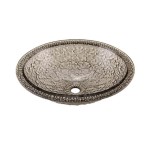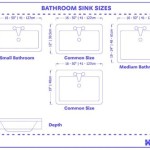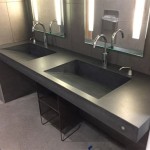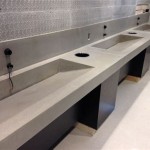How To Install A Bathroom Extractor Fan
Installing a bathroom extractor fan is a crucial step in maintaining a healthy and comfortable home environment. These fans effectively remove excess moisture, preventing the growth of mold and mildew, reducing unpleasant odors, and improving air quality. While it may seem daunting, installing an extractor fan is a manageable DIY project with careful planning, the right tools, and adherence to safety precautions. This article provides a comprehensive guide to the process, from selecting the appropriate fan to completing the final wiring.
Planning and Preparation: Selecting the Right Fan
Before commencing the installation, careful planning and preparation are essential. The first step involves selecting the appropriate extractor fan for the specific bathroom. Several factors influence this decision, including the size of the bathroom, the level of humidity typically experienced, and any applicable building codes or regulations.
Bathroom Size and Fan Capacity: The capacity of an extractor fan is measured in cubic feet per minute (CFM). A general rule of thumb is to calculate the required CFM by multiplying the bathroom's square footage by 1.1. For bathrooms larger than 100 square feet, additional consideration should be given to features like high ceilings or frequent shower use. In these situations, a fan with a higher CFM rating is recommended.
Fan Type and Features: Extractor fans come in various types, each with its own set of features and benefits. Axial fans are typically more affordable and suitable for smaller bathrooms with shorter duct runs. Centrifugal fans are more powerful and can handle longer duct runs, making them ideal for larger bathrooms or situations where the fan needs to be located further from the exterior vent.
Consider also features like noise level (measured in sones), humidity sensors, timers, and integrated lighting. A humidity sensor automatically activates the fan when humidity levels rise above a certain threshold, ensuring efficient moisture removal. A timer allows the fan to run for a set period after the light switch is turned off, preventing lingering moisture. Integrated lighting can provide additional illumination in the bathroom.
Ducting and Venting: The selection of appropriate ducting is crucial for the effective operation of the extractor fan. Flexible or rigid ducting can be used, but rigid ducting generally provides better airflow. The ducting should be properly sized to match the fan's outlet and should be as short and straight as possible to minimize airflow resistance. Selecting a suitable vent location to expel moist air outside the home is also important. This can be through the roof, a side wall, or a soffit.
Electrical Considerations: Before purchasing a fan, it is imperative to check the electrical requirements and ensure compatibility with the existing wiring. Most bathroom extractor fans operate on standard 120V AC power. Ensure that the circuit breaker is appropriately sized and that the wiring is in good condition. If unsure, consulting a qualified electrician is highly recommended.
Gathering Tools and Materials
Once the appropriate fan has been selected, the next step is to gather all the necessary tools and materials. Having everything on hand before starting the installation will streamline the process and minimize delays.
Essential Tools: The following tools are typically required for installing a bathroom extractor fan:
- Safety Glasses
- Gloves
- Ladder
- Stud Finder
- Pencil
- Drill with various drill bits (including a hole saw)
- Screwdrivers (both Phillips head and flathead)
- Wire Strippers
- Wire Connectors
- Electrical Tester (Non-contact voltage tester)
- Duct Tape or Foil Tape
- Utility Knife
- Measuring Tape
- Pry Bar
- Level
Required Materials:
- Bathroom Extractor Fan Kit (including fan, housing, and grill)
- Ducting (flexible or rigid of appropriate size)
- Exterior Vent Cover
- Screws and Anchors
- Electrical Wiring (if required)
- Caulk or Sealant
Safety Precautions: Prioritize safety by wearing safety glasses and gloves throughout the installation process. Always turn off the power to the circuit at the circuit breaker before working with any electrical wiring. Use an electrical tester to confirm that the power is off before touching any wires. If uncomfortable working with electricity, it is strongly advised to hire a qualified electrician.
Installation Process: Step-by-Step Guide
The installation of a bathroom extractor fan involves several steps, each requiring careful attention to detail. This section provides a step-by-step guide to ensure proper installation and functionality.
1. Marking the Location: Determine the optimal location for the fan, ideally near the shower or toilet where moisture is most prevalent. Use a stud finder to locate ceiling joists and avoid cutting into them. Mark the outline of the fan housing on the ceiling using a pencil, ensuring that it is centered between joists.
2. Cutting the Opening: Using a drywall saw or a utility knife, carefully cut along the marked outline to create the opening for the fan housing. Proceed cautiously to avoid damaging the surrounding ceiling. If cutting through any existing wiring, ensure that the power is off and that the wiring is properly rerouted.
3. Installing the Fan Housing: Insert the fan housing into the opening and secure it to the ceiling joists using screws or nails. Ensure that the housing is level and flush with the ceiling surface. If necessary, use shims to level the housing properly. Some fan housings may require additional support brackets for added stability.
4. Connecting the Ducting: Attach the ducting to the fan housing outlet using duct tape or foil tape. Ensure a secure and airtight connection to prevent air leakage. Run the ducting to the exterior vent location, ensuring that it is as short and straight as possible. Secure the ducting to the ceiling joists or rafters using zip ties or duct straps to prevent sagging.
5. Installing the Exterior Vent: Cut an opening in the exterior wall or roof for the vent cover. Ensure that the opening is appropriately sized for the vent. Insert the vent cover into the opening and secure it with screws or nails. Seal around the vent cover with caulk or sealant to prevent water infiltration. Connect the ducting to the vent cover outlet using duct tape or foil tape.
6. Wiring the Fan: Turn off the power to the circuit at the circuit breaker. Connect the electrical wiring to the fan's wiring according to the manufacturer's instructions. Typically, this involves connecting the black (hot) wire, the white (neutral) wire, and the green (ground) wire using wire connectors. Ensure that all connections are secure and properly insulated. If the existing wiring is insufficient, new wiring may need to be installed from a nearby junction box. Consulting a qualified electrician is highly recommended in this case.
7. Installing the Fan Grill: Attach the fan grill to the fan housing according to the manufacturer's instructions. The grill typically snaps into place or is secured with screws. Ensure that the grill is securely attached and that it is flush with the ceiling surface.
8. Testing the Fan: Turn on the power to the circuit at the circuit breaker. Test the fan to ensure that it is operating properly. Check for excessive noise or vibration. Verify that the fan is effectively removing moisture from the bathroom. If the fan is equipped with a humidity sensor or timer, test those features to ensure that they are functioning correctly.
Troubleshooting Common Issues
Even with careful installation, some issues may arise. Here are some common problems and potential solutions:
Fan Not Working: If the fan does not turn on, check the circuit breaker to ensure that it has not tripped. Verify that the wiring connections are secure and that the fan is receiving power. If the fan still does not work, the motor may be defective and require replacement.
Excessive Noise: Excessive noise can be caused by loose fan blades, a defective motor, or improper ducting. Check the fan blades for any damage and ensure that they are securely attached. If the motor is noisy, it may need to be lubricated or replaced. Ensure that the ducting is properly supported and that it is not vibrating against any surfaces.
Poor Airflow: Poor airflow can be caused by undersized ducting, a clogged duct, or a defective fan. Ensure that the ducting is appropriately sized for the fan. Check the duct for any obstructions, such as debris or kinks. If the fan is not providing sufficient airflow, it may need to be replaced with a model with a higher CFM rating.
Moisture Buildup: If moisture continues to build up in the bathroom despite the fan running, ensure that the fan is adequately sized for the bathroom. Check the ducting for any leaks or disconnected sections. Verify that the exterior vent is properly installed and that it is not blocked by snow or debris. Consider installing a fan with a humidity sensor to ensure that it runs automatically when humidity levels are high.
By following these steps and addressing any potential issues, individuals can successfully install a bathroom extractor fan and improve the air quality and comfort of their homes. However, if unsure about any aspect of the installation, consulting a qualified professional is always recommended.

Extractor Fan Wiring Diywiki

How To Wire A Bathroom Extractor Fan With Timer Diy Doctor

What Parts Do I Need To Install An Inline Fan In My Bathroom

How To Wire A Bathroom Extractor Fan With Timer Home Electrical Wiring

How To Install An Extractor Fan

Extractor Fan Wiring Diywiki

Domestic Fan Installation Compliance Checker Vent Axia

How To Install An Extractor Fan In A Ceiling

Extractor Fan Wiring Diywiki

Installing A Bathroom Extractor Fan With Timer
Related Posts







